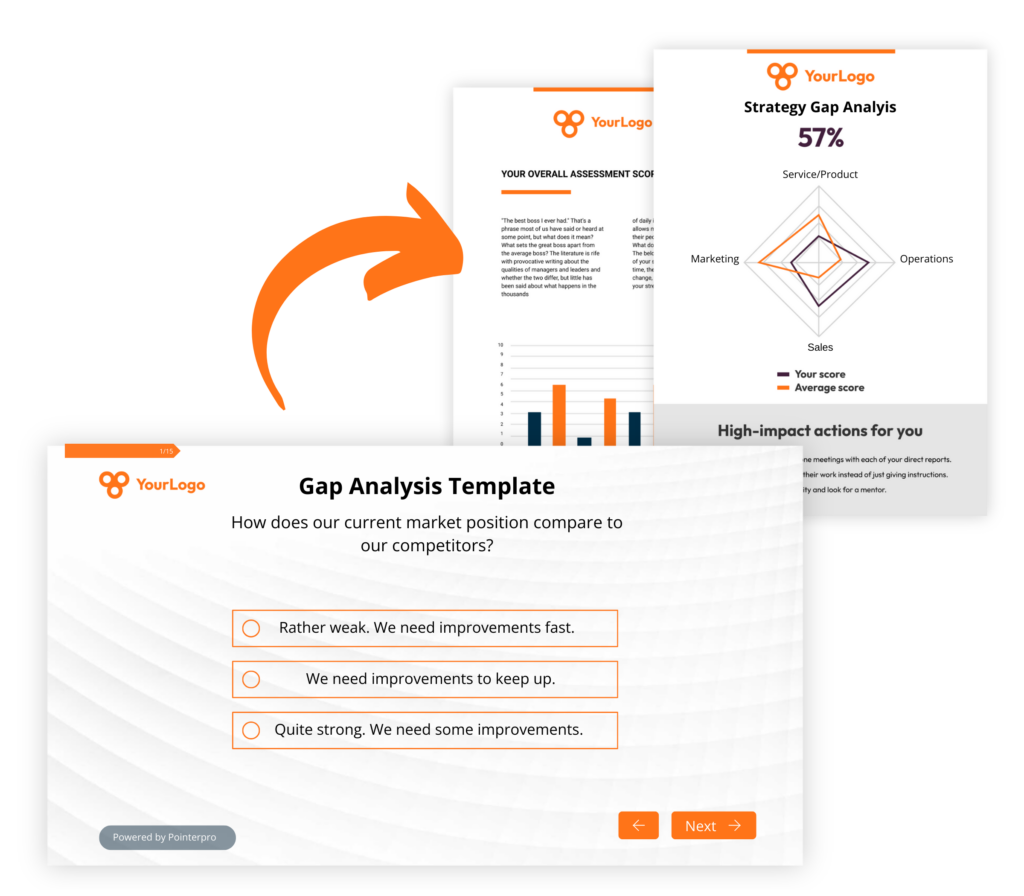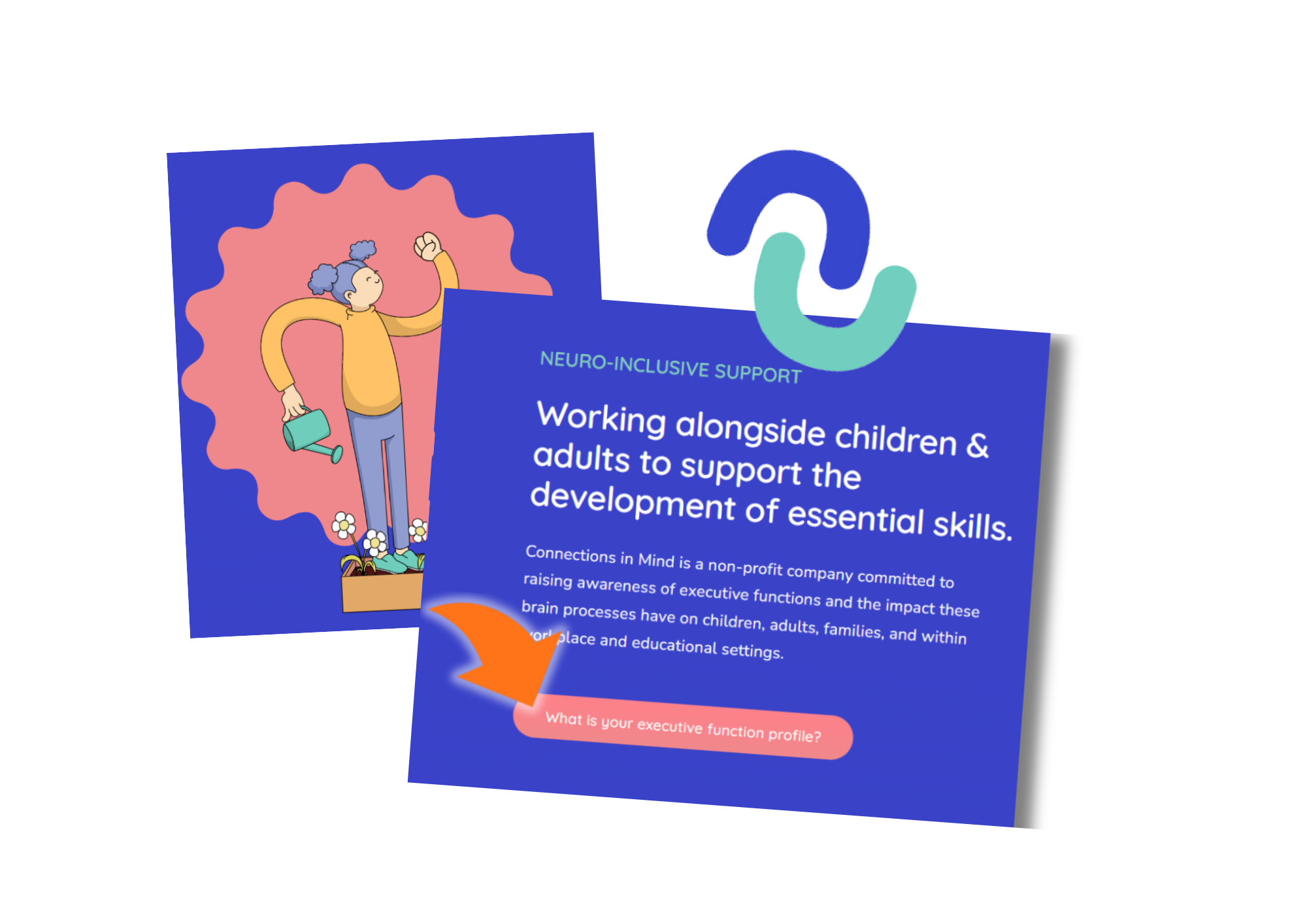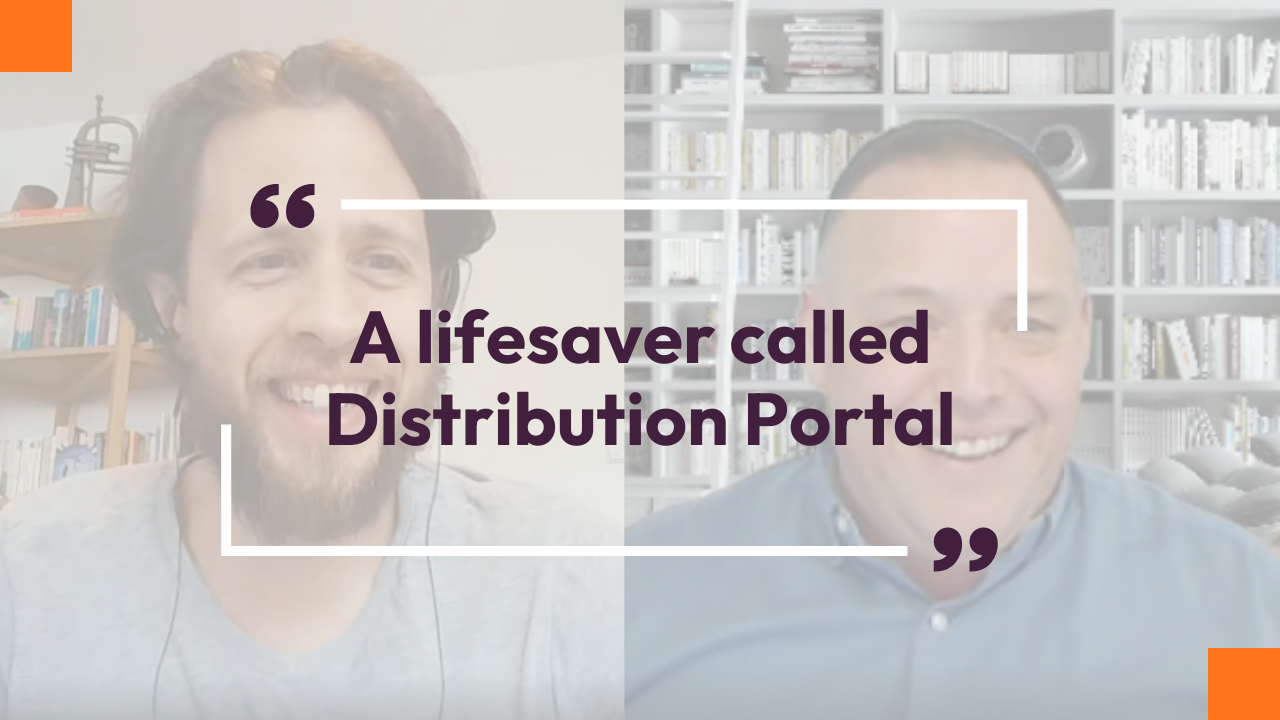Gap analysis template
Are you looking for a way to evaluate where your own or your customer’s organization stands?
With the right gap analysis template you get everyone on track to make the necessary improvements.
Pointerpro is the 2-in-1 software that combines assessment building with personalized PDF feedback report generation.

What is a gap analysis?
Mind the gap! As the term suggests, a gap analysis is an objective assessment of where an organization currently stands versus where it aspires to be. Typical gap analyses exist in the domain of business strategy, the evaluation of businesses’ services, or skills assessment
It’s a strategic planning tool often employed in business, project management, and various other contexts to identify areas for improvement and guide decision-making.
A solid gap analysis is based on the following:
- Clear objectives: Measurable goals that the organization wants to achieve. These could include financial targets, operational efficiency improvements, quality standards, etc.
- A maturity model: This is the definition of the best possible future state and all the potential states before. Each state represents a level of “readiness” or “maturity”, based on the combined objectives. Each state also entails targets. Typically consultants and organizations define 4 to 5 maturity levels.
- A scored assessment: Based on the maturity model, questions and quantifiable answer options are defined. Each maturity level corresponds with a score range. For instance, a score of 1 to 10 might indicate level 1 maturity. A score of 11 to 20 might indicate level 2. A score of 21 to 30 might indicate level 3, and so on.
- A pre-defined action plan: Reaching the optimal level, always implies moving up step by step. Therefore, you should define a template action plan to move from level 1 to 2, 2 to 3, and so on. This may involve implementing new processes, acquiring additional resources, providing training and development opportunities, or making other changes to close the gaps. That action plan template can be translated into an automated report any respondent receives after finishing your assessment questionnaire.
Note: You can add various layers to your assessment and pre-defined action plan. For instance, you can define different categories that are part of the overall assessment and define advice or required actions per each category.
E.g., A marketing strategy assessment could consist of “brand strategy”, “digital strategy,” “content strategy.”
3 reasons to use Pointerpro as a gap analysis tool
3 reasons to use Pointerpro as a gap analysis tool
Interactive user experience
With the Questionnaire Builder, you get to create an engaging feedback form. How? With numerous design and layout options, useful widgets, and countless question types.
Refined, score-based analysis
Our custom scoring engine helps you quantify and categorize diverse answers. The result? An objective and nuanced gap analysis that helps you take action.
Automated feedback in PDF
Thanks to your setup in the Report Builder, employees get a detailed gap analysis and action plan in a PDF report: with personalized and objective feedback.
1.500+ businesses worldwide build assessments with Pointerpro









Gap analysis methods or models vs gap analysis tools
When talking about gap analysis templates, people tend to confuse methods (or models) with tools.
Gap analysis methods or models refer to the conceptual frameworks used to conduct a gap analysis. A simple maturity model, as explained above, is an example of such a framework. A well-known example of a gap analysis method/maturity model in the world of consultancy is the McKinsey 7S framework. This model assesses seven key elements of an organization (strategy, structure, systems, shared values, skills, style, and staff) to identify gaps and ensure alignment for effective performance.
Gap analysis tools range from basic tools to full-fledged tools. The most basic tool example would be a spreadsheet tool, like Excel. Excel is often used for basic gap analysis by creating spreadsheets to compare current and desired states, calculate discrepancies, and visualize data using charts or graphs. The most advanced – though user-friendly – tool example would be Pointerpro. It offers data collection through questionnaires (a Questionnaire Builder), a powerful assessment engine to set up custom scoring logic, and automated feedback report generation based on respondent answers (a Report Builder). This includes a limitless array of charts.
Here’s a simple explanation of custom scoring and why it’s important in assessments:
Gap analysis vs needs assessment: what’s the difference?
Needs assessments are often conflated with gap analyses. Though often complementary, they are not the same.
The essential difference between gap analysis and needs assessment lies in their primary focus and purpose. A gap analysis aims to compare the current state of affairs or performance with a desired future state or goal, identifying discrepancies or “gaps” between the two. It evaluates existing situations or processes relative to predefined standards or expectations, with the intention of developing strategies to bridge these gaps and improve overall performance.
In contrast, a needs assessment is centered on better understanding the specific needs to bridge identified gaps.
Gap analysis vs maturity assessment: what’s the difference?
Maturity assessments and gap analyses are also often conflated. And conceptually a maturity or gap analysis template is indeed highly similar. Both can be based based on the same maturity model, with the same predefined maturity levels.
The subtle difference is that a gap analysis concentrates on identifying gaps between current and desired states, while according to its definition, a maturity assessment seems to be focused on simply determining the organization’s maturity level.
However, the power of any assessment lies in the follow-up action it inspires. So, as far as Pointerpro is concerned, you can consider a gap analysis and a maturity assessment to be the same thing.
Here’s a short video of our colleague Stacy, explaining “maturity models:”
Gap analysis example questions
Here are 30 gap analysis example questions divided into 3 categories
- 10 strategic gap analysis example questions
- 10 service gap analysis example questions
- 10 skills gap analysis example questions
10 strategic gap analysis example questions
- What are our current business objectives, and how do they align with our long-term strategic goals?
- What key performance indicators (KPIs) are we currently tracking, and are they effectively measuring progress towards our objectives?
- How does our current market position compare to our competitors?
- How prepared are we for emerging trends or technologies that are impacting our industry?
- Are there any gaps in our product or service offerings compared to customer needs and preferences?
- How does our current workforce skillset align with the demands of our future business goals, and what training or development initiatives are needed to bridge any gaps?
- Are there any regulatory changes or compliance requirements on the horizon that could affect our operations, and are we prepared to address them?
- What are the strengths and weaknesses of our current marketing and branding strategies, and to what extent can we enhance our brand presence in the market?
- Are there any operational inefficiencies or bottlenecks hindering our ability to achieve our objectives, and to what extent can we streamline processes to improve efficiency?
- How does our current financial performance compare to our financial targets, and what strategies can we implement to drive revenue growth and cost optimization?
These gap analysis template questions can serve as a starting point for conducting a strategic gap analysis, helping organizations identify areas where improvements or interventions are needed to bridge the gap between their current state and desired future state.
Strategy gap analysis plays a pivotal role in ensuring the alignment between an organization’s current and desired state. By systematically comparing existing strategies, processes, and performance against predefined goals and benchmarks, strategy gap analysis reveals critical discrepancies and areas for improvement.
10 service gap analysis example questions
- How do customer expectations for our services compare to the actual service delivery provided by our organization?
- Are there any gaps between the quality of service our customers expect and the quality they perceive they receive?
- What specific aspects of our service delivery process are most valued by customers, and how well are we meeting their expectations in those areas?
- How do customers perceive the responsiveness and timeliness of our service delivery compared to their desired levels?
- Are there any discrepancies between the service features or options customers desire and those currently offered by our organization?
- What communication channels do customers prefer for interacting with our organization, and how effectively are we meeting their needs through these channels?
- How do customers perceive the competence and professionalism of our service providers, and are there any areas for improvement?
- Are there any gaps in the accessibility or convenience of our services for customers, and how can we address them?
- What are the most common reasons for customer complaints or dissatisfaction, and how can we mitigate these issues to improve service quality?
- Are there any opportunities to exceed customer expectations and differentiate our services from competitors, and if so, how can we capitalize on them?
These service gap analysis template questions can serve as a starting point for conducting a comprehensive service gap analysis, helping organizations identify areas for improvement in service delivery and customer satisfaction.
10 skills gap analysis example questions
- What are the key skills and competencies required for success in our organization or industry, and how do they align with the skills possessed by our current workforce?
- Are there any specific technical skills or certifications that are in high demand within our industry, but lacking among our employees?
- What soft skills, such as communication, leadership, or problem-solving, are essential for effective performance in our organization, and how do employees rate themselves in these areas?
- Are there any emerging skills or technologies that employees need to acquire to stay competitive in their roles, and how can we facilitate their development?
- How do the skills and expertise of our employees compare to those required for future roles or career progression within the organization?
- Are there any gaps in language proficiency or cultural competence that may impact our ability to serve diverse customers or collaborate effectively in global teams?
- What training or development opportunities are available to address identified skills gaps, and how accessible are they to employees?
- Are there any mentorship or coaching programs in place to support employees in acquiring new skills or advancing their careers, and how effective are they?
- How do employees perceive the availability of resources and support for skill development within the organization, and what improvements can be made?
- Are there any incentives or recognition programs in place to encourage employees to acquire new skills or pursue professional development opportunities, and how impactful are they?
These skills gap analysis template questions can help organizations identify gaps in employee skills and competencies, prioritize training and development initiatives, and ensure alignment between workforce capabilities and organizational objectives.
More standardized gap analysis templates
Several standardized gap analysis frameworks exist, each tailored to specific industries, processes, or objectives. Some of the most commonly used standardized gap analysis templates or frameworks include:
- Balanced scorecard: This is a strategic planning and management framework that translates an organization's vision and strategy into a set of performance measures across four perspectives: financial, customer, internal processes, and learning and growth. By evaluating performance against these balanced metrics, organizations can identify gaps and prioritize initiatives to improve overall performance.
- Nadler-Tushman Congruence Model: This framework examines the congruence or alignment between various elements within an organization, including strategy, structure, tasks, people, and culture. Similar to the McKinsey 7S Framework, it helps organizations assess how well these elements fit together and identify areas of misalignment that may impede organizational effectiveness.
- Burke-Litwin Model: The Burke-Litwin Model identifies twelve organizational factors, grouped into transformational factors (such as leadership, organizational culture, and mission) and transactional factors (such as structure, systems, and management practices). By analyzing the interactions between these factors, organizations can identify key drivers of change and areas where interventions are needed to address performance gaps.
- Sar model: Developed by Jay R. Galbraith, the Star Model consists of five interconnected elements: strategy, structure, processes, rewards, and people. This framework emphasizes the interdependencies between these elements and helps organizations align them to support strategic objectives effectively. It provides a holistic view of organizational effectiveness and facilitates gap analysis by highlighting areas where alignment is lacking.
- Hambrick and Fredrickson's Strategy Diamond: This framework focuses specifically on strategy formulation and execution. It identifies five elements of strategy—arenas, vehicles, differentiators, staging, and economic logic—and examines the alignment between them. By analyzing these elements, organizations can assess the coherence of their strategic approach and identify gaps that may hinder successful strategy implementation.
What Pointerpro clients are saying




Gap analysis report: Best practices
A well-crafted gap analysis report is a cornerstone for organizational improvement and strategic decision-making. It not only distills complex findings and insights into a clear and actionable format but also provides a roadmap for addressing identified gaps and achieving desired outcomes.
A good report not only communicates the current state of affairs and areas for improvement but also provides stakeholders with the necessary context, analysis, and recommendations to drive meaningful change.
By synthesizing data, analysis, and recommendations into a coherent narrative, a good report empowers leaders to make informed decisions, allocate resources effectively, and prioritize initiatives that will have the greatest impact on organizational success.
Here are some best practices for creating a comprehensive and effective gap analysis report in a PDF document:
- Clear executive summary: Begin the report with a concise executive summary that provides an overview of the purpose, scope, key findings, and recommendations of the gap analysis.
- Detailed methodology: Include a section outlining the methodology used to conduct the gap analysis, including data sources, analysis techniques, and any tools or frameworks utilized.
- Current state assessment: Present a thorough analysis of the current state, including strengths, weaknesses, and performance metrics relevant to the objectives of the analysis.
- Desired future state: Clearly define the desired future state or goals the organization aims to achieve, providing a benchmark for comparison with the current state.
- Gap analysis findings: Present the findings of the gap analysis, identifying specific gaps or discrepancies between the current state and the desired future state across various dimensions.
- Root cause analysis: Include an analysis of the root causes contributing to identified gaps, examining internal and external factors that may be influencing performance.
- Recommendations and action plan: Provide actionable recommendations for bridging the identified gaps, including specific strategies, initiatives, and timelines for implementation.
- Follow-up assessment (optional): In case the gap analysis isn’t enough to formulate a follow-up action plan, it’s strongly recommended to follow up with a risk assessment, to assess the potential risks and challenges associated with implementing any potential actions. Another recommendation would be setting up a needs assessment to better understand the needs that exist to bridge any identified gaps.
- Resource requirements: Specify the resources (e.g., financial, human, technological) needed to implement the recommended actions effectively.
- Monitoring and evaluation: Outline a plan for monitoring progress towards closing the identified gaps, including key performance indicators (KPIs) and milestones for tracking.
- Conclusion: Summarize the key findings, implications, and next steps, reiterating the importance of addressing identified gaps to achieve organizational objectives.
- Appendices: Include any supplementary information, data, or supporting documentation relevant to the gap analysis, such as survey results, interview transcripts, or additional analysis.
Create your first gap analysis today
You may also be interested in
Recommended reading

How Connections In Mind benefits the community interest through a digital mindset and a longitudinal assessment
The fact that communities benefit from diversity should not be news to anybody. One type of diversity you may not

Vlerick Business School digitalizes entrepreneurship development with Pointerpro [case study]
What do a top-tier international business school based in the capital of Europe and Pointerpro have in common? At the

Attain Global: How to do psychometric tests right and build a cutting-edge international business [case study]
In many countries worldwide, the pursuit of skillful and engaged employees is not so much a war on talent as


